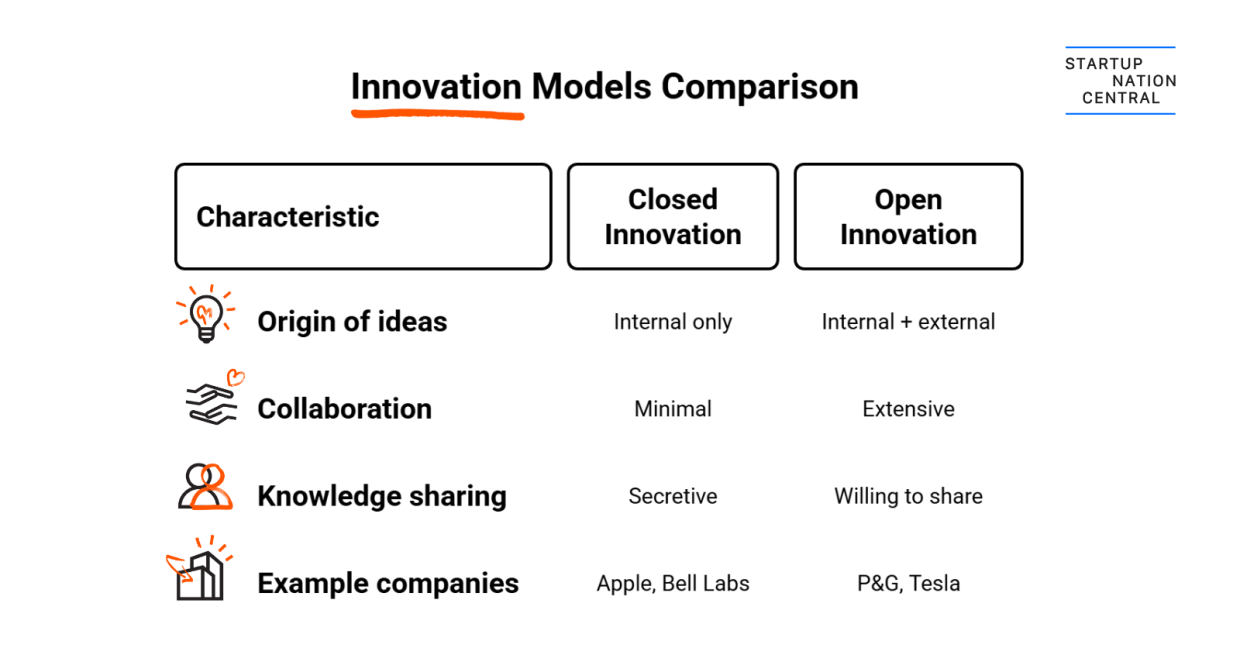Open Innovation and its Advantages
Tech Innovation
Innovation has long been a cornerstone of business success. Traditionally, companies relied solely on internal research and development to drive progress, a model known as closed innovation. However, in today’s interconnected and rapidly evolving landscape, this approach can be limiting. Enter open innovation: a paradigm that embraces external ideas and collaborations to enhance a company’s innovation capabilities.
Henry Chesbrough, who coined the term “open innovation,” in his book on the topic, explains it best: “Open innovation is a paradigm that assumes that firms can and should use external ideas as well as internal ideas, and internal and external paths to market.”
Understanding Open Innovation
Open innovation, as explained in our Startup Terms Glossary, involves “using both internal and external ideas to accelerate innovation.” This translates to integrating external knowledge, ideas, and technologies into a company’s innovation process. This can include partnerships with startups, collaborations with universities, engaging with customers, or even co-developing products with other firms. The goal is to leverage a broader pool of resources and perspectives to drive innovation more efficiently and effectively.
Open vs. Closed Innovation
The primary distinction between open and closed innovation lies in the source and flow of ideas:
- Closed Innovation relies exclusively on internal R&D, keeping discoveries within the company’s boundaries until product launch.
- Open Innovation encourages the inflow and outflow of knowledge, allowing companies to utilize external ideas and share internal innovations with others.
While closed innovation offers control and confidentiality, it can also lead to insular thinking and missed opportunities. Open innovation, conversely, fosters collaboration and adaptability which are essential traits in today’s dynamic markets.

Benefits of Open Innovation
One of the key advantages of open innovation is access to diverse expertise. By working with external partners—whether startups, universities, or individual experts—companies can inject fresh perspectives and specialized knowledge into their innovation processes. This influx of new thinking can help organizations tackle complex problems more effectively and stay ahead of trends.
Another major benefit is the potential to accelerate time-to-market. Rather than building solutions from the ground up, businesses can leverage existing technologies and ideas, shortening development cycles and gaining a competitive edge.
This approach also helps control costs. Sharing research and development efforts across partners reduces the burden on any single organization, allowing them to reallocate resources or invest in other strategic areas. This model can be especially valuable for startups or small teams looking to expand their capabilities without taking on unsustainable overhead.
In addition, spreading innovation efforts across multiple contributors reduces overall risk. If one avenue doesn’t work, another may succeed, thereby creating a more resilient innovation pipeline.
Finally, companies that embrace open innovation often gain a long-term competitive advantage. By staying open to external ideas and actively participating in innovation networks, they become more adaptable and better positioned to respond to shifting market demands. This creates a culture of collaboration that can support sustained growth over time.
Large Brands Leveraging This Approach
Many large brands companies have successfully implemented open innovation strategies. Here are four popular examples:
- Procter & Gamble (P&G) developed products through its “Connect + Develop” program, co-creating with external innovators.
- General Electric (GE) launched initiatives like the Ecomagination Challenge to crowdsource clean technology ideas from startups and entrepreneurs.
- LEGO invites fans to submit new product ideas through its LEGO Ideas platform. Several community-submitted sets have become commercial successes.
- NASA uses open calls and crowdsourced problem-solving through platforms like the NASA Tournament Lab to address complex technical challenges.
The use of this strategy by huge names makes it clear that this is a practical, scalable approach used by organizations around the world.
Open Innovation in the Israeli Startup Ecosystem
Israel, often dubbed the “Startup Nation,” is an example of the successful implementation of open innovation. The country’s vibrant tech ecosystem thrives on collaboration between startups, multinational corporations, academic institutions, and government agencies.
Israeli startups frequently engage in partnerships with global companies, contributing cutting-edge technologies across various sectors, including cybersecurity, agritech, and health tech. These collaborations not only provide startups with access to resources and markets but also offer established companies innovative solutions to complex challenges.
Startup Nation Central’s Role
Startup Nation Central plays a pivotal role in promoting open innovation within Israel’s tech ecosystem. As a non-profit organization, Startup Nation Central connects Israeli startups with global corporations, investors, and academic institutions, fostering collaborations that drive technological advancements.
Startup Nation Central’s initiatives include:
- Corporate Partnerships linking startups with multinational companies seeking innovative solutions
- Academic Collaborations facilitating connections between tech stakeholders and universities to promote research and development
- Innovation Ecosystem Mapping providing comprehensive data and insights into Israel’s tech landscape to identify collaboration opportunities
- Investor Engagement connecting startups with global and local investors through curated deal flow, real-time data, and strategic matchmaking, empowering founders to scale faster and attract long-term capital
Through these efforts, Startup Nation Central empowers Israeli startups, accelerating their growth and contributing to global technological progress.
Ready for Startup Nation Central to help you collaborate? Learn more here.


 Tech Ecosystem
Tech Ecosystem Human Capital
Human Capital Focus Sector
Focus Sector The Health Network
The Health Network
 Business Opportunities
Business Opportunities Investment in Israel
Investment in Israel Innovation Diplomacy
Innovation Diplomacy Leadership Circle
Leadership Circle
